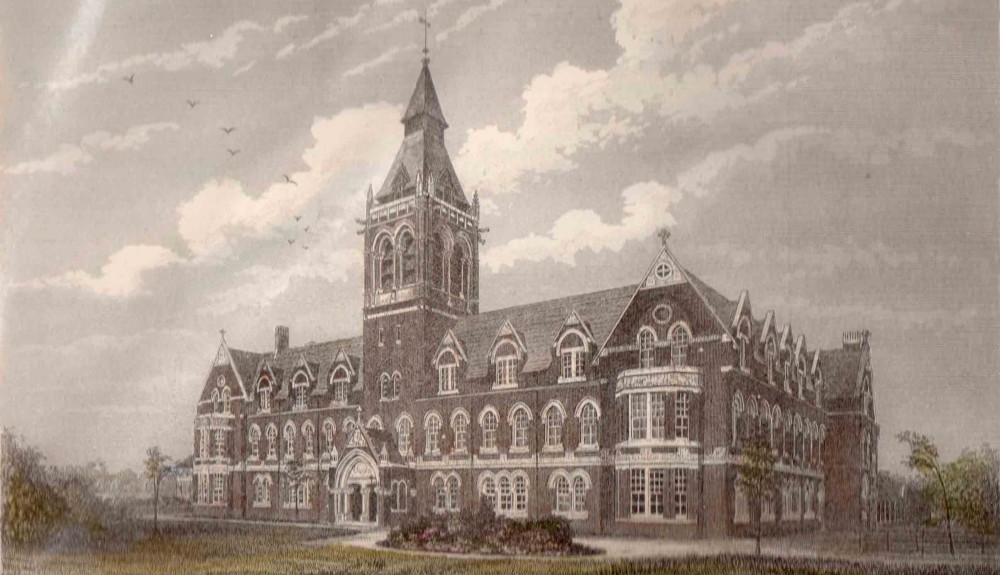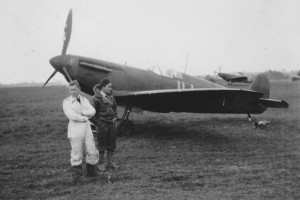Douglas “Sammy” Hoare first from left
Douglas “Sammy” Hoare (Emanuel 1929-1935) 74 Squadron RAF – recounts his experiences in the lead up to his capture in France during the evacuation – May 1940. His full story can be found in Emanuel School at War: The Greatest Scrum That Ever Was
Dunkirk – May 1940
During May 1940 Douglas, by now a Flying Officer, was contemplating the situation on the continent as the Germans launched their invasion of France and the Low Countries.
On 10 May, the day the invasion was launched, Douglas was looking forward to some leave when he wrote to his mother, ‘I was looking forward very much to the weekend at home and possibly a day at the coast. I expect Dick [Wildey] has been recalled also – it really is most annoying that the Blitzkrieg should have to start this weekend and just when
my leave is starting too.’
On 21 May 1940 Douglas wrote again to his mother: ‘I don’t think I have written since you sent my Portcullis [Emanuel School Magazine] – thank you very much for it. It was very interesting reading through that list and seeing what some of the other fellows are doing.
There is actually hardly anything to say as everything here is still just the same as before
and there is very little real activity. We have had one or two more trips to the Dutch and
Belgian coast but have not seen anything worth shooting at. There is absolutely no sign
of life at all in any of the towns over there and we saw quite a number of large fires in Dunkirk which had been started by a raid the previous night. I hope that everyone is taking ARP [Air Raid Precaution] seriously now as it will not be very long before we get
some raids over here – that is when we shall start really hard work. The situation in France seems pretty bad at present but perhaps we will bring off a really good counter-attack soon. We are also very proud of the RAF squadrons out there – and slightly envious, though we are all quite certain we shall get all the chance we want when it starts over here.‘
In May 1940 No. 74 Squadron was engaged on operations over the French Coast during the German Blitzkrieg which forced the BEF to coastal waters in a bid to escape the ferocity and speed of the German advance. On 24 May Douglas noted, ‘I was leading the sub-section of B Flight 74 Squadron on an offensive patrol over the Channel Ports. (Intelligence at that [time] was almost non-existent and we had no idea where
the German front line was).’ He went on to describe what happened that day:
We had on that occasion seen a Henschel 126, a German reconnaissance aircraft. Although our instructions were to patrol just the Channel coastline, we were told
that we could go inland, if we were investigating any aircraft, or for some other reason; in this case we had seen this other aircraft. Paddy Treacy had seen it and I was leading the second section. We must have been somewhere around St Omer, about 15 miles inland.
The Henschel was flying very low and in fact by the time I went into attack it with my section, it was down to about treetop height. It was in flames and just as I pulled away, I saw it crash and go up in a pall of smoke. Anyway, I managed to collect a bullet from somewhere; it may have been a German infantryman or light flack. It may have been from our own troops on the ground, or even the Henschel we’d just shot down. Nevertheless I reformed and intended to go back to base, when Mungo-Park called me up and said I was streaming glycol; so I thought the sensible things to do was what Squadron Leader White had done the previous day and go into Calais-Marck airfield. I knew the previous day that we had sent two ground crew over to the airfield to service his aircraft and repair it. I thought if I can get in here, perhaps they can do a quick patch up and then I can get home. But it didn’t work out that way, and I was too late. At that time the military intelligence just could not keep up with the speed of the German advance westwards. We were not told the disposition of British and French forces nor where the front line was (did anyone know!) and there was never any mention of an evacuation. In fact Calais had been reinforced only the previous day with a British armoured unit. When I landed on the airfield Corporal Higginbottom and Aircraftsman Cressay came out, and were beside the aircraft immediately; I told them what had happened. They saw a hole on the side of the engine cowling; … We found quite a large hole in the pipe leading. … Before I had landed my radiator temperature gauge, my oil temparature and pressure gauges were all registering well above the limits.‘
With German troops approaching the three men made their escape through the long grass. In a spirited but unsuccessful attempt Douglas and Corporal Higginbottom, (Aircraftsman Cressay had become separated from the two men and was later captured), made their way due north and on two ‘borrowed’ bicycles reached the coast, but they failed in their attempt to get any boat off the sand dunes and on the evening of 25 May, along with French civilians and some British Army officers they were surrounded on the beaches between Calais and Dunkirk by an SS Panzer unit. Douglas explained what happened to him next: ‘We did quite a bit of walking from the beach where I was first captured until reaching Germany in early June. The first organised POW camp I reached was Dulag Luft–III but this was only a transit and interrogation place and I moved a few days later.‘
For the next four years Douglas was a POW. He spent time in eleven camps including the following, with dates:
Spangenberg – Oflag IXA(H) (RAF Camp), Jun–Jul 40
Barth – Stalag Luft–I, Jul 40–Feb 41
Spangenberg – Oflag IXA(H), Feb–Mar 41
Thorne (Poland) – Stalag Luft–XXA, Mar–May 41
Spangenberg – Oflag IX(H), Jun–Oct 41
Warburg – Oflag VIB, Oct 41–Aug 42
Schubin (Poland) – Oflag XXIB, Aug 42–Apr 43
Sagan – Stalag Luft–III, Apr 43–Aug 44
Gross Tychow – Stalag Luft–IVD, Aug–Sep 44
Further reading:
‘Douglas S Hoare’ by Daniel Kirmatzis in Daniel Kirmatzis and Tony Jones, Emanuel School at War: The Greatest Scrum That Ever Was (2014), pp. 494-498
Richard C. Smith, Hornchurch Scramble: The Definitive Account of the RAF Fighter Airfield, Its Pilots, Groundcrew and Staff, Volume One: 1915 to the End of the Battleof Britain (2002)

